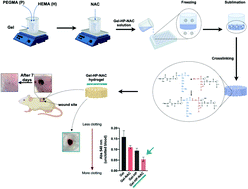Improvement of the wound healing properties of hydrogels with N-acetylcysteine through their modification with methacrylate-containing polymers
Abstract
Hydrogels with antioxidant activity have shown to significantly improve the standard of care, because they promote efficient wound healing, i.e. regeneration. N-Acetylcysteine (NAC) is an antioxidant amino acid derivative that promotes complete tissue restoration. However, NAC has anticoagulant properties that may also hinder blood coagulation, which is crucial for hydrogels for wound healing applications. To take advantage of the regenerative activity of NAC while avoiding hampering the hemostasis stage during wound healing, we modified gelatin-NAC with the methacrylate-containing polymers 2-hydroxyethyl methacrylate (H) and poly(ethylene glycol) methyl ether methacrylate (P) to produce Gel-HP-NAC. These hydrogels clotted more blood and faster than Gel and Gel-NAC hydrogels, while maintaining fluid absorption properties adequate to promote wound healing. Similarly, there were more viable human skin fibroblasts after 10 days cultured in Gel-HP-NAC compared with Gel and Gel-NAC. A mouse full-thickness skin wound model demonstrated that Gel-HP-NAC hydrogels improved the wound healing process as compared to the untreated group as proved by the increased wound closure rates and re-epithelialization. Histology of the biopsied tissues indicated more organized collagen deposits on the wounds treated with either Gel-HP-NAC or Gel-NAC than untreated wounds. Our results show that modification of NAC-containing hydrogels through methacrylate-containing polymers improved their wound healing properties, including blood-clotting, and demonstrate the potential of Gel-HP-NAC hydrogels for wound treatment and tissue regeneration.



 Please wait while we load your content...
Please wait while we load your content...